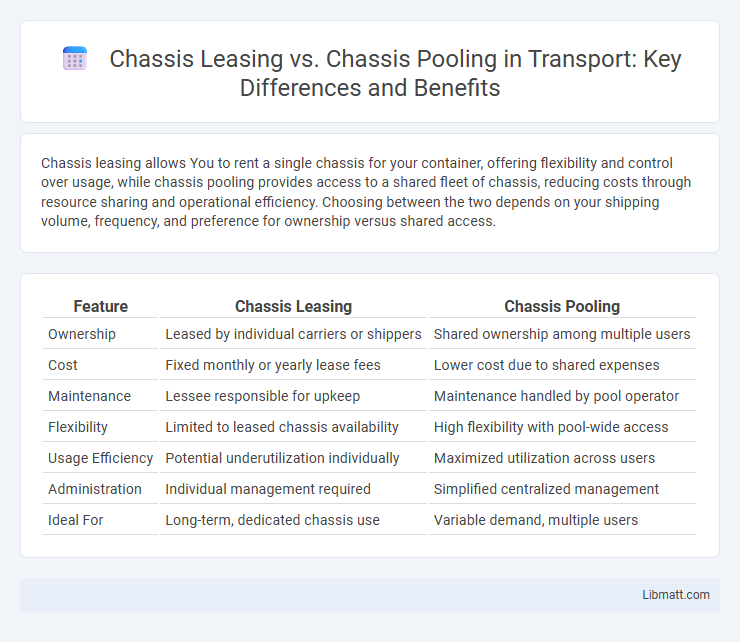Chassis leasing allows You to rent a single chassis for your container, offering flexibility and control over usage, while chassis pooling provides access to a shared fleet of chassis, reducing costs through resource sharing and operational efficiency. Choosing between the two depends on your shipping volume, frequency, and preference for ownership versus shared access.
Table of Comparison
| Feature | Chassis Leasing | Chassis Pooling |
|---|---|---|
| Ownership | Leased by individual carriers or shippers | Shared ownership among multiple users |
| Cost | Fixed monthly or yearly lease fees | Lower cost due to shared expenses |
| Maintenance | Lessee responsible for upkeep | Maintenance handled by pool operator |
| Flexibility | Limited to leased chassis availability | High flexibility with pool-wide access |
| Usage Efficiency | Potential underutilization individually | Maximized utilization across users |
| Administration | Individual management required | Simplified centralized management |
| Ideal For | Long-term, dedicated chassis use | Variable demand, multiple users |
Introduction to Chassis Leasing and Chassis Pooling
Chassis leasing involves renting individual chassis units from a provider, offering flexibility for companies needing temporary or variable equipment without the capital investment. Chassis pooling, on the other hand, allows multiple carriers or shippers to share a common fleet of chassis, improving asset utilization and reducing costs through collective ownership or access agreements. Both models address equipment management in intermodal shipping but differ in operational control, cost structure, and logistical coordination.
What is Chassis Leasing?
Chassis leasing involves renting a trailer chassis from a third-party provider for a specific period, offering flexibility without the burden of ownership or maintenance costs. This option allows you to access well-maintained equipment and scale your fleet according to fluctuating shipping demands. Leasing provides control over your transportation assets while reducing upfront investment and administrative responsibilities.
What is Chassis Pooling?
Chassis pooling is a logistics solution where multiple shipping companies share a centralized inventory of chassis, improving equipment availability and reducing costs by eliminating the need for each company to own and maintain their own chassis fleet. This system enhances operational efficiency and flexibility by allowing You to access the right chassis when and where needed without the burden of individual chassis management. Unlike chassis leasing, which involves renting equipment from a single provider, pooling leverages collective resources to optimize asset utilization across the entire network.
Key Differences Between Chassis Leasing and Pooling
Chassis leasing involves renting a specific chassis for a set period, offering you dedicated equipment and control over maintenance schedules. Chassis pooling provides access to a shared fleet of chassis, enhancing flexibility and reducing costs by eliminating the need for individual chassis ownership. The key differences lie in asset control, cost structure, and operational flexibility, with leasing granting exclusivity and pooling promoting resource sharing.
Cost Comparison: Leasing vs Pooling
Chassis leasing typically involves fixed monthly fees and higher long-term costs due to maintenance and depreciation, whereas chassis pooling offers variable expenses based on usage, often reducing overall expenditures by eliminating ownership costs. Pooling allows access to a shared fleet, lowering upfront capital investment and minimizing downtime costs associated with chassis availability. For companies with fluctuating shipping volumes, chassis pooling provides a cost-effective alternative, while leasing benefits operations needing consistent, dedicated equipment.
Operational Flexibility and Efficiency
Chassis leasing offers your business operational flexibility by allowing customized lease durations and the ability to scale your fleet based on demand fluctuations, optimizing asset management and reducing idle time. Chassis pooling enhances efficiency through shared access to a centralized inventory, minimizing wait times and rental costs while ensuring equipment availability at multiple locations. Balancing leasing and pooling strategies can streamline operations, improve turnaround times, and lead to cost-effective supply chain management.
Maintenance and Responsibility
Chassis leasing requires you to handle maintenance and repairs either by yourself or through the leasing company, often resulting in higher costs and logistical challenges. Chassis pooling shifts the responsibility of maintenance and upkeep to the pool provider, ensuring well-maintained equipment and reducing downtime for your operations. Leasing offers control but increases your maintenance burden, whereas pooling optimizes efficiency by transferring responsibility to specialized management.
Impact on Supply Chain and Logistics
Chassis leasing offers supply chains flexibility by enabling carriers to access equipment without large capital investments, which can reduce downtime and improve equipment availability in fluctuating demand scenarios. Chassis pooling centralizes equipment resources, optimizing asset utilization and decreasing empty repositioning miles, thus enhancing overall logistics efficiency and reducing operational costs. Both models influence supply chain fluidity, with pooling often providing greater predictability in chassis availability while leasing supports rapid scaling and adaptability.
Environmental and Regulatory Considerations
Chassis leasing and chassis pooling offer distinct environmental benefits, with leasing often resulting in higher emissions due to individual equipment logistics, whereas pooling reduces carbon footprints by optimizing chassis utilization and minimizing empty repositioning trips. Regulatory frameworks increasingly favor chassis pooling as it supports sustainability goals, adhering to emissions reduction targets and promoting resource efficiency in the transportation sector. Compliance with environmental regulations is more streamlined through chassis pooling, leveraging shared assets to meet stricter emission standards and reduce overall environmental impact.
Choosing the Right Model: Leasing or Pooling
Choosing between chassis leasing and chassis pooling depends on your operational needs and cost management priorities. Leasing chassis offers consistent availability and maintenance control, making it suitable for businesses with steady, long-term volume and specific equipment requirements. Chassis pooling provides flexibility and cost savings through shared resources, ideal for companies with fluctuating demand or those seeking to minimize capital expenditure and maintenance responsibilities.
chassis leasing vs chassis pooling Infographic

 libmatt.com
libmatt.com